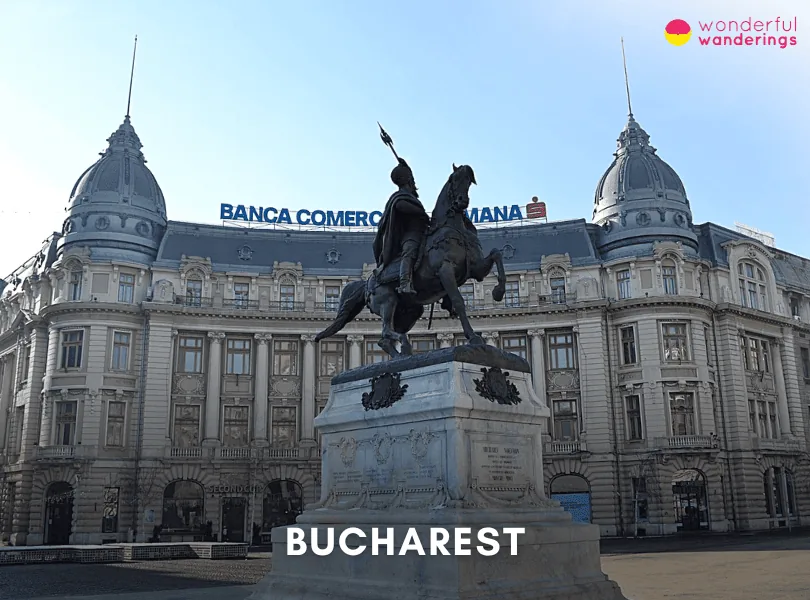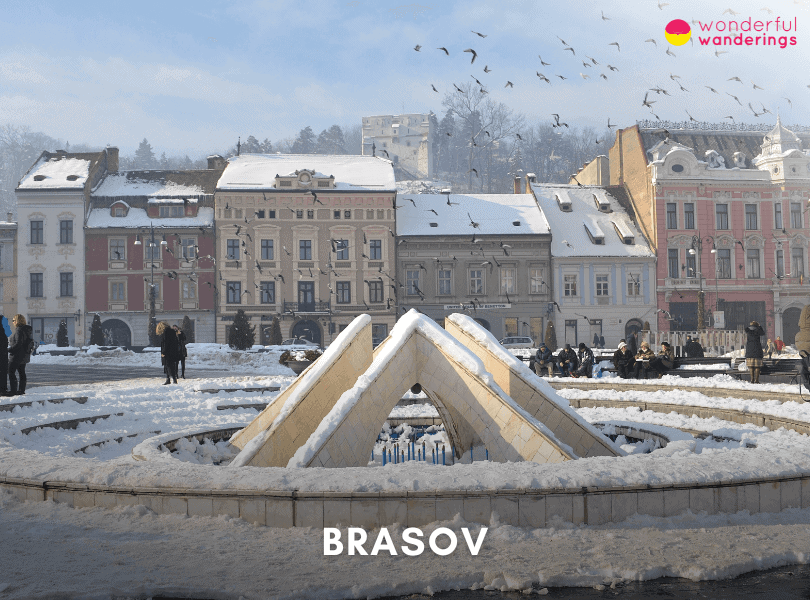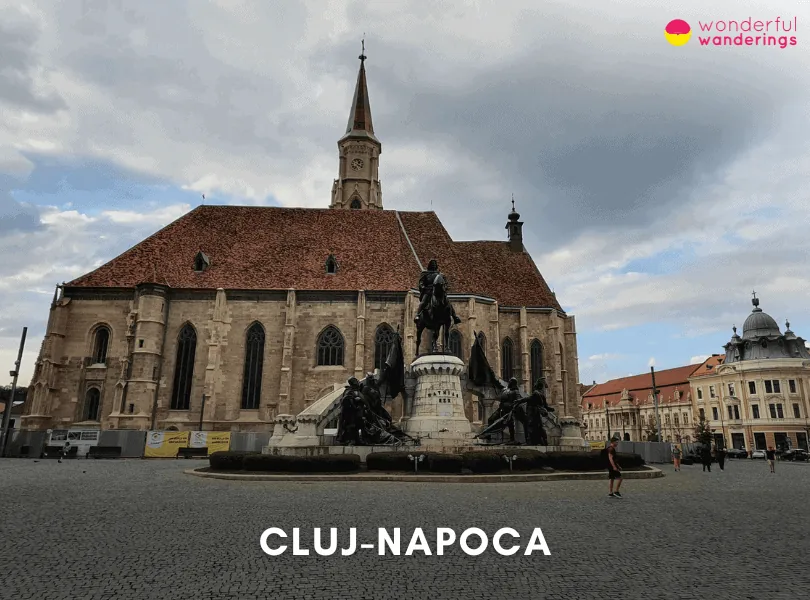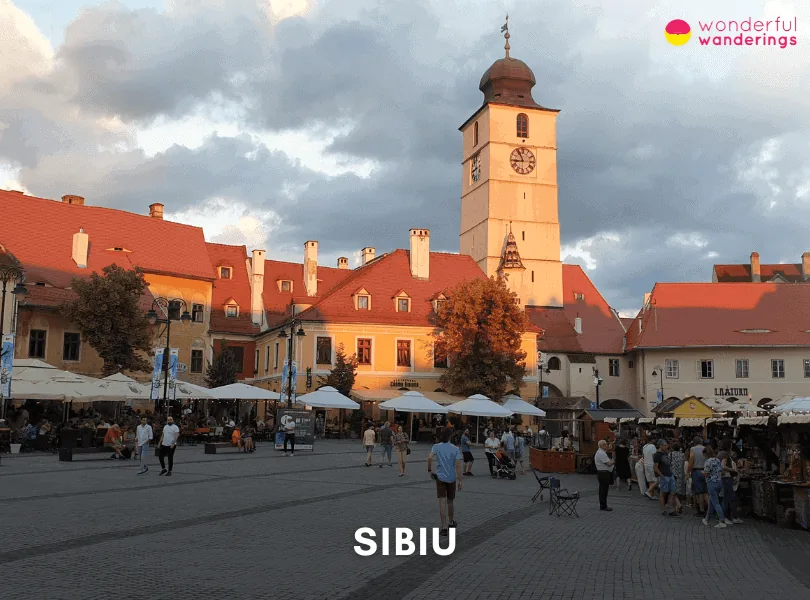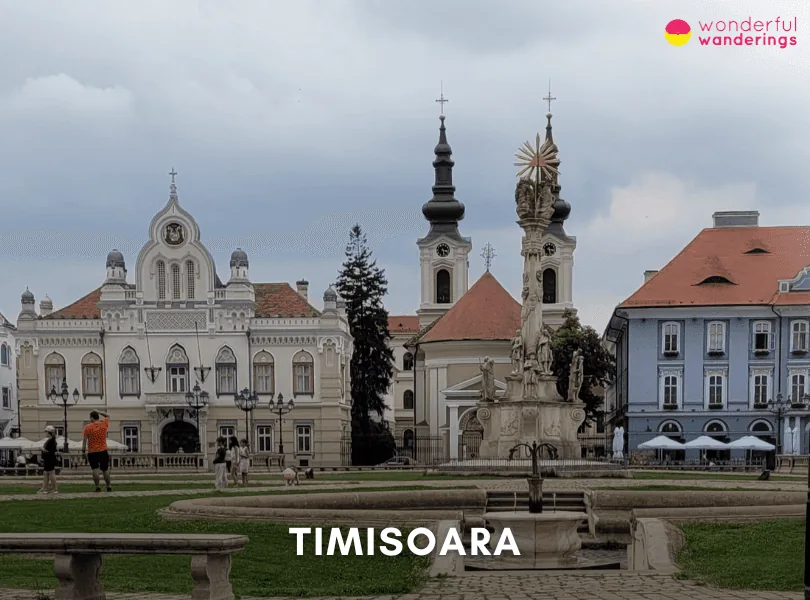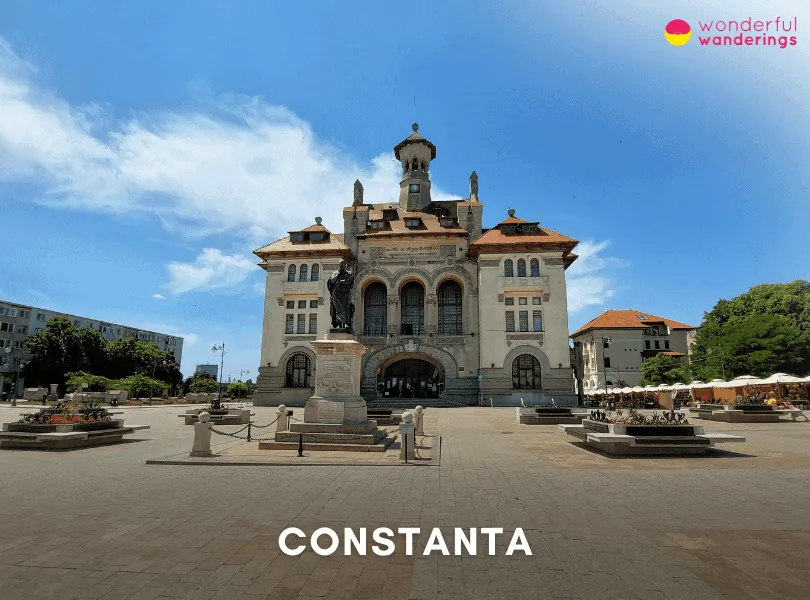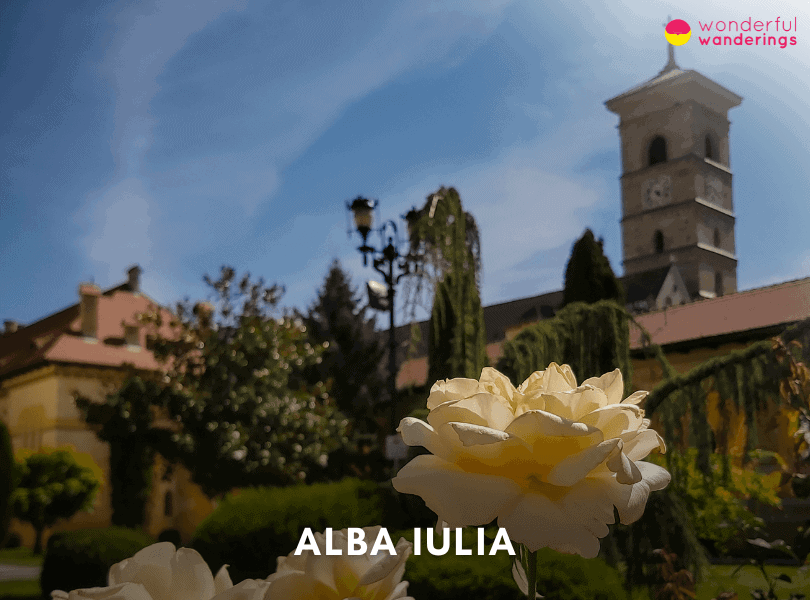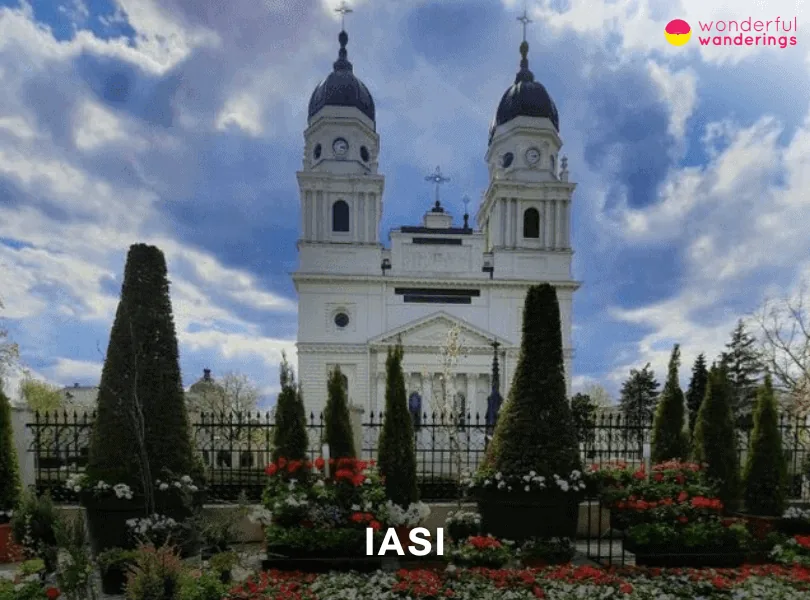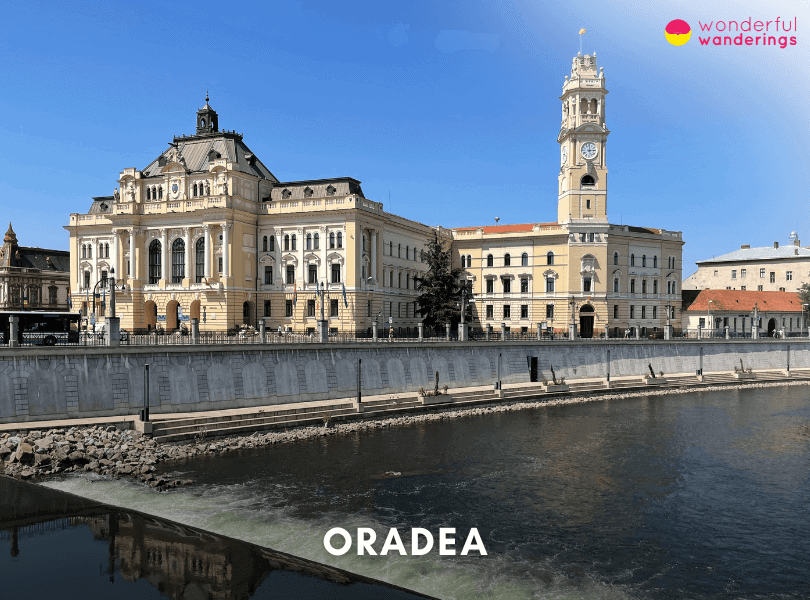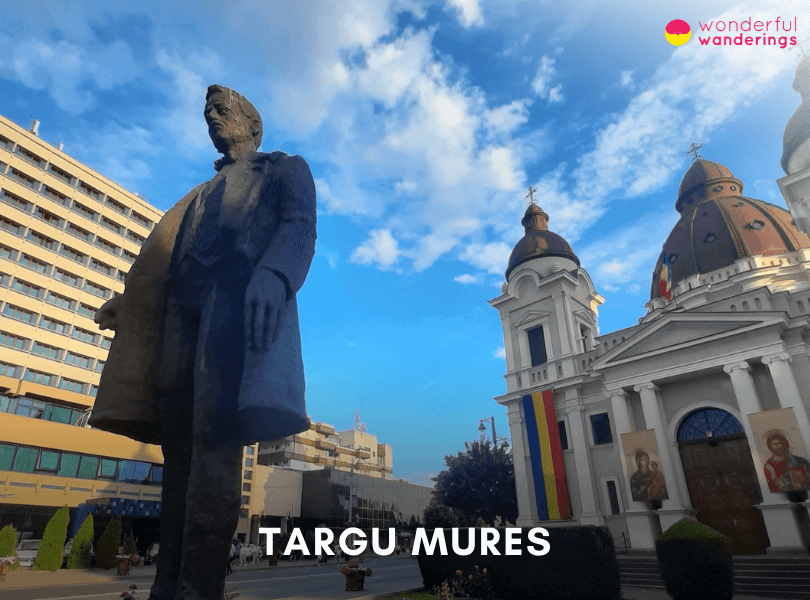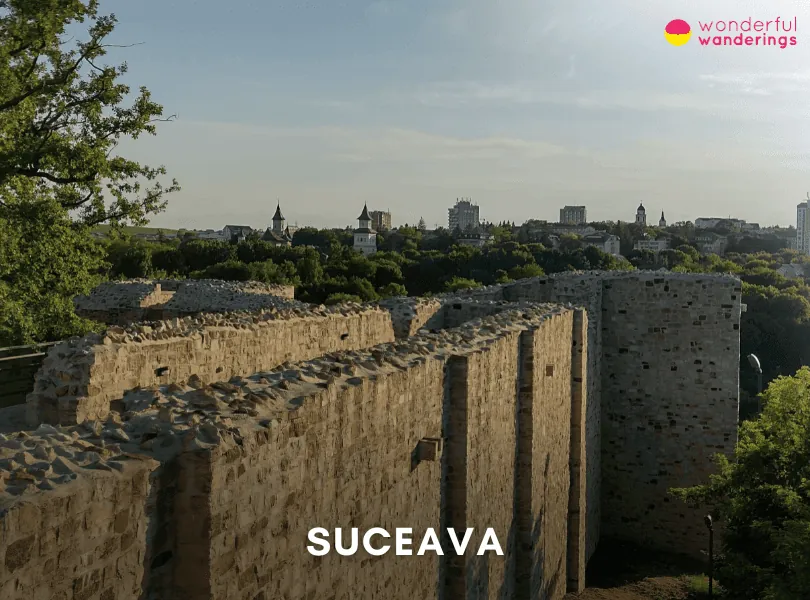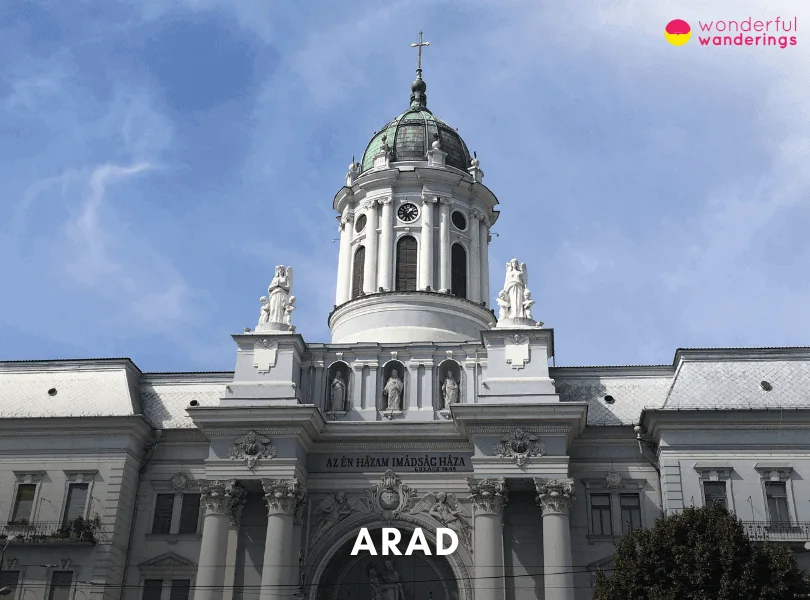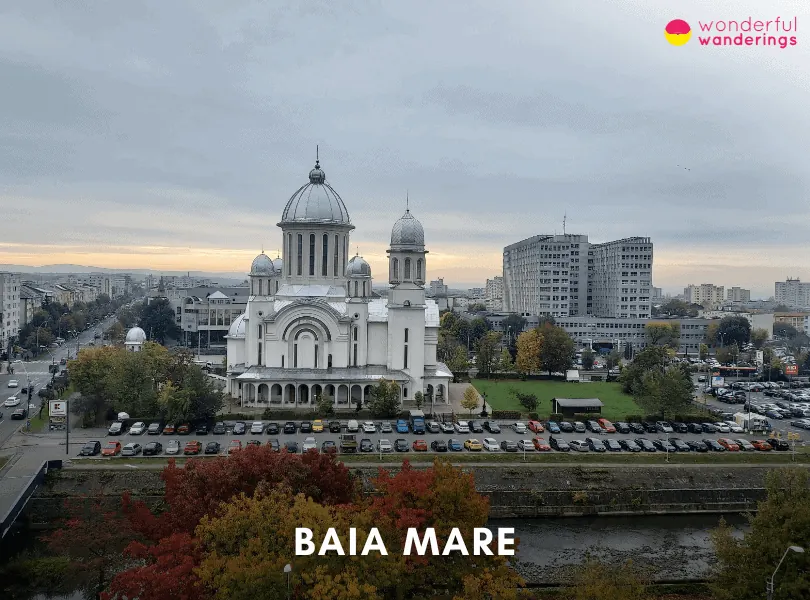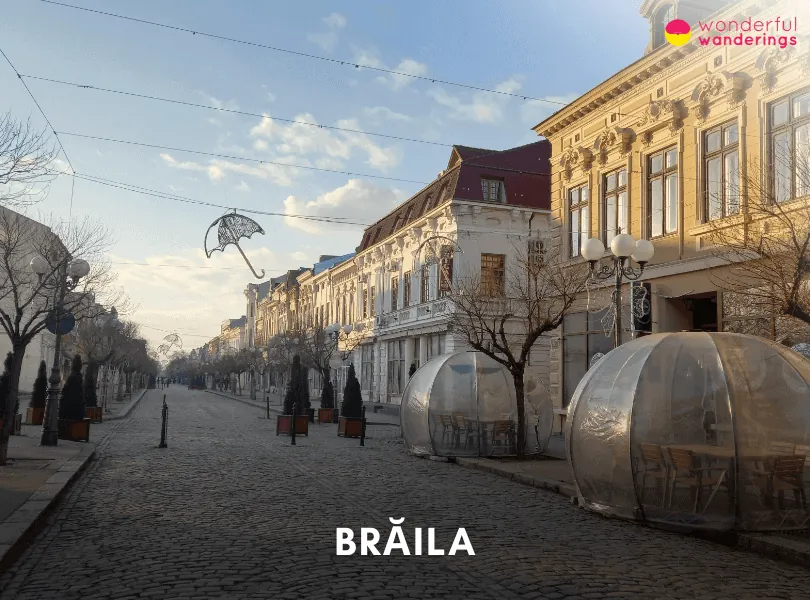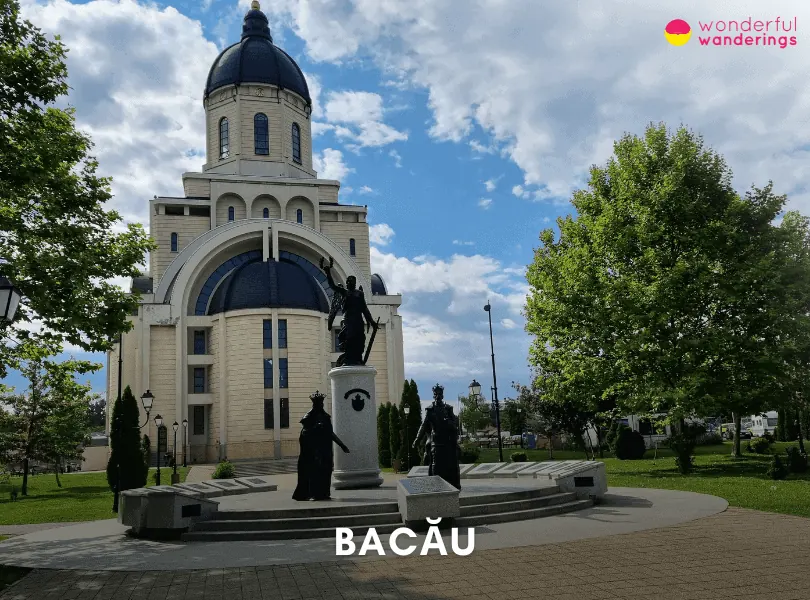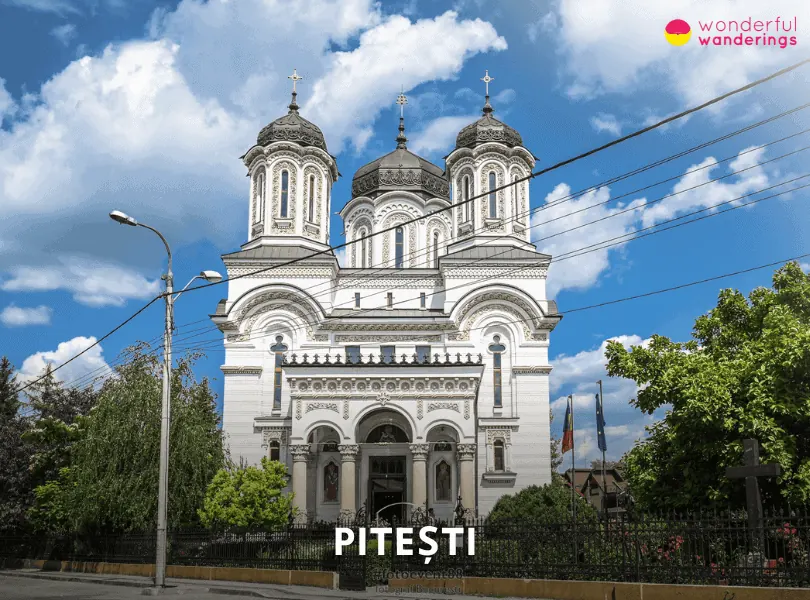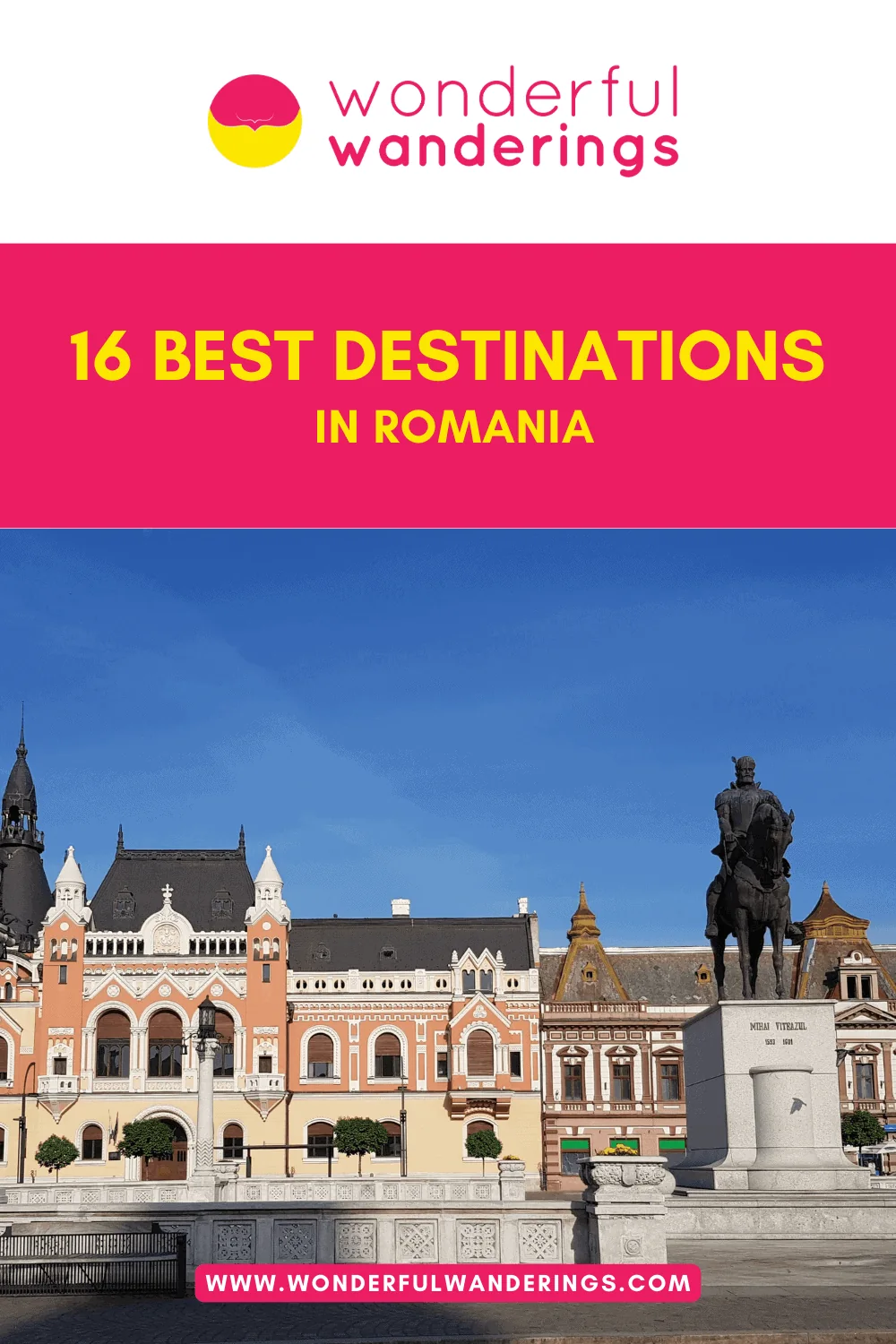Romanian cuisine reflects diverse influences from its history under rulers like the Ottoman Empire. Regional specialties also vary based on the historical impacts of groups like Germans, Hungarians and Turks. Visitors will enjoy exploring Romania’s flavorful national dishes and regional variations reflecting the climate and diverse cultural influences. Romania also offers a wide range of accommodation that caters especially for budget travelers. Romania has a temperate continental climate with four distinct seasons. Summers are hot, frequently reaching 86°F (30°C). Winters are quite cold, with temperatures as low as 23°F (-5°C) and regular snowfall. Spring (April-May) and fall (September-October) offer mild weather ideal for sightseeing.
1. Bucharest
Bucharest is the capital and largest city of Romania. It is located in the southeast of the country, on the banks of the Dâmbovița River, 140 kilometers (65 miles) north of the Danube River and the Bulgarian border. Bucharest has a rich history stretching back to the 15th century when it was first mentioned as the “City of Bucharest”. Bucharest has served as the capital of Wallachia and the Romanian United Principalities and has been an important center of culture, commerce and politics. The major historical events associated with Bucharest include the Treaty of Bucharest, which ended the Russo-Turkish War in 1812 and the palace coup in 1989 that led to the fall of communism in Romania.
Bucharest has a dynamic, cosmopolitan vibe. It boasts a thriving food scene, lively nightlife and plenty of museums, galleries, theaters and other cultural attractions. One of the top things to see and do in Bucharest is to take a walking tour of the historic Lipscani district, the old commercial heart of the city packed with restaurants, bars and architectural gems. Visit the gargantuan Palace of Parliament and learn about the controversial Nicolae Ceaușescu era.
Relax in Cismigiu Gardens, Bucharest’s oldest and most beautiful public garden, dating back to 1847. Explore the open-air Village Museum, home to 272 authentic peasant farms and buildings across Romania. See world-class art at the National Art Museum, from medieval icons to works by Renoir and Picasso. Catch a show at the Romanian Athenaeum, a lavishFrench-neoclassical concert hall that hosts performances by the George Enescu Philharmonic and party into the night in the colorful Old Town (Centru Vechi), Bucharest’s main nightlife zone, with bars, clubs and live music venues.
Bucharest is an urban area with a population of 1,817,938 as of 2023. The city has 226 square kilometers (8.7 square miles). The GPS coordinates of central Bucharest are roughly 44.4327° N and 26.1025°. Bucharest features a mix of architectural styles, from medieval Romanian to neoclassical, art nouveau and communist-era concrete apartment blocks. The city center contains many historic landmarks like the Romanian Athenaeum concert hall, Curtea Veche (the Old Princely Court) and Casa Poporului (the Palace of Parliament, the world’s largest civilian administrative building). The most convenient way to reach Bucharest is by flying into Henri Coandă International Airport. Bucharest’s Henri Coanda International Airport is located 16 kilometers (9 miles) from downtown Bucharest. Bucharest has excellent public transportation, including buses, trams, trolleys and a subway system, which makes getting around the city easy.
Bucharest enjoys a temperate continental climate, with warm summers and cold winters. The best times to visit are April to June and September to October when temperatures are warm. Summers can get quite hot, with temperatures sometimes reaching 40°C. Winters are cold, with average highs around 0°C in January and nighttime lows dropping below -10°C. It frequently snows in winter. Bucharest offers something for all types of travelers. Spend a few days exploring Romania’s capital to appreciate its cosmopolitan charm and complex history. It is recommended to stay for 2 to 3 days, which is enough time to see the highlights of Bucharest. Two to three days are enough to tour the city’s historic center and its most important neighborhoods. This number of days allows immersion into Bucharest and surrounding areas, including multiple day trips and time to sample local cuisine and culture.
2. Brasov
Brasov is a city in Romania, located in the central part of the country, 166 kilometers (103 miles) north of Bucharest and 380 kilometers (236 miles) from the Black Sea. The Carpathian Mountains surround it and are part of the historical region of Transylvania. The city was founded in 1211 by the Teutonic Knights and later settled by the Saxons, becoming one of Transylvania’s seven-walled citadels. Brasov was an important commercial hub on the trade routes between the Ottoman Empire and Western Europe, contributing to its prosperity. Brasov was founded in the early 13th century by the Teutonic Knights, who built a citadel called Kronstadt or ‘Crown City’.These Saxon colonists developed Brasov, engaging primarily in trade and crafts. Brasov grew wealthy, given its location on trading routes and certain tax exemptions. The Saxon population strongly influenced the city’s architecture and culture. Brasov endured invasions and sieges but often managed to retain autonomy. Romanians began affirming their identity and campaigning for rights. Brasov became part of Romania in 1918 after Transylvania’s union with the kingdom. Many ethnic Germans were later expelled or fled the region.
Brasov is home to an array of tourist attractions. Brasov’s major attractions include the Black Church, the largest Gothic church between Vienna and Istanbul, with origins dating back to the 14th century. The medieval fortifications and defense towers built around the city starting in the 15th century are also popular sites, including Ecaterina’s Gate, the only original city gate still standing. The Council Square in the historic city center features colorful baroque buildings and cafes. Mount Tampa, rising above the city, has a large “Hollywood-style” Brasov sign and offers panoramic views from its peak. Brasov has a cultural scene with numerous museums, galleries and theaters and a wide range of restaurants and cafes serving traditional Romanian cuisine.
Brasov had a population of 267,480 as of 2023, making it one of the largest cities in Romania. Brasov has a humid continental climate with warm summers and freezing winters. Its location in a mountain valley leads to a relatively high level of air humidity. The city is located at latitude 45.65 degrees north and longitude 25.60 degrees east. Avram Iancu International Airport is the nearest international airport in Cluj-Napoca at 172 kilometers (107 miles). Avram Iancu International Airport is located 435 kilometers (270 miles) from Bucharest. Brasov will be opening its airport in the near future. By road, Brasov is located 168 kilometers (105 miles) north-northwest of Romania’s capital and largest city, Bucharest. The train is the best option for most visitors as it balances cost, time and convenience. Some of the most convenient ways to travel to Brasov include flying into Bucharest and then taking the train, riding the bus, which takes 2.5-3 hours or hiring a private driver or taxi service to drive you directly there. Various companies also offer international routes into Brasov from cities across Europe.
The best time to visit Brasov is generally spring through early autumn, from April to October when the weather is mild and ideal for outdoor activities. Summer is peak tourist season and quite busy, while winter is freezing but offers a snow-covered landscape in the city and opportunities for skiing and other cold weather sports nearby. Some of the best festivals also take place during summer and winter. Visitors should be prepared for rain or freezing temperatures in the mountains. It is recommended to stay for 2 to 3 days, which is enough time to see the highlights of Brasov. This number of days allows immersion into Brasov and surrounding areas, including multiple day trips and time to sample local cuisine and culture. Two to three days is enough time to see the highlights of Brasov itself; this allows visitors to visit the Old Town, Black Church, Council Square, Tampa Mountain and other tourist destinations. The number of days allows tourists to do day trips from Brasov to nearby sights like Bran Castle, Rasnov Fortress, Peles Castle, etc. These make for great side trips but require traveling outside the city.
3. Cluj-Napoca
Cluj-Napoca is located in the Someșul Mic River valley in northwest Romania, 323 kilometers (201 miles) from Cluj-Napoca, 350 kilometers (218 miles) from Budapest, Hungary and 321 (200 miles) from Belgrade, Serbia. It sits roughly equidistant from those three major cities in the historical region of Transylvania. Cluj-Napoca has a long history, having been part of many empires and kingdoms over time, including the Roman Empire, the Hunnic Empire, the Kingdom of Hungary, the Austrian Empire and modern Romania. The area was settled in antiquity and was home to the Dacian settlement of Napoca. The Romans conquered Dacia in 106 CE and founded the city of Napoca. It was an important Roman outpost for centuries. The area changed hands many times before becoming part of the Kingdom of Hungary in the Middle Ages. Cluj served as the capital of the Grand Principality of Transylvania from 1790 to 1848 and from 1861 to 1867. Cluj continues to be an essential economic, academic and cultural center in Romania.
Cluj-Napoca is home to tourist attractions such as Union Square which features Saint Michael’s Church, a huge Gothic church, as well as other historic landmarks like the Old Banffy Palace and the old town hall. The square is located in the historic city center and is surrounded by cozy bars. Museum Square features the Franciscan Monastery and the Transylvania History Museum. It is one of the oldest market squares in the city. Nearby is the house where Matthias Corvinus was born in the 15th century. Avram Iancu Square is another key square located near the Romanian National Opera House. It features a statue honoring Avram Iancu, a Romanian nationalist peasant leader from the mid-19th century. Cluj-Napoca hosts several major annual festivals like Untold (electronic music), Transylvania International Film Festival (TIFF) and Electric Castle Festival.
Cluj-Napoca has a population of 324,576 people as of 2023, making it the second most populous city in Romania after Bucharest. Sixteen percent of the population consists of Hungarians. Cluj-Napoca lies at an altitude of 310–350 meters above sea level, at the coordinates 46°45′34′′N 23°35′9′′E. Cluj-Napoca International Airport (CLJ) is 9 kilometers (5.5 miles) east of the city center. The distance between Cluj-Napoca and Romania’s capital Bucharest is 406 kilometers (308 miles) by road. The convenient way to get to Cluj-Napoca is by plane, with regular flights from Bucharest and other major European cities. The city has good road, rail and air connectivity to other parts of Romania as well as international destinations. Cluj-Napoca is well connected to most cities in Romania as well as Budapest, Hungary. The city lies on the European routes E60, E81 and E576. Daily bus routes connect it to most towns in Romania and to Budapest.
The best times to visit Cluj-Napoca are late spring (May-June) and early autumn (September-October). Summers can get hot and humid, while winters are cold, sometimes dropping below -10°C. Cluj-Napoca hosts most open-air concerts and festivals during these months. Accommodation costs are highest during this peak festival season. It is recommended to stay for three days, which is enough time to see the highlights of Cluj-Napoca. Spending three days allows visitors to explore the top sights like Central Park, St. Michael’s Church, the museums and Old Town and have time for day trips to nearby places like Turda Salt Mine. Three days provide enough time to get a good sense of visitors to get to know Cluj-Napoca.
4. Sibiu
Sibiu is a city in central Romania located in the historical region of Transylvania. Sibiu was founded by German settlers in the 12th century and was an important mercantile and cultural center. Sibiu went through great change in the 20th century, from the collapse of the Austro-Hungarian empire through its integration into Greater Romania. The Saxon population of the city declined after World War II. In recent decades, Sibiu has undergone restoration and modernization, making it a popular tourist destination. It was designated the European Capital of Culture in 2007, along with Luxembourg. Sibiu is a city located in central Romania in the historical region of Transylvania. It serves as the county seat of Sibiu County and is an important economic, industrial, cultural and tourism center.
The main sights and attractions in Sibiu’s well-preserved old town include the Grande Square and Little Square, which feature pastel-colored houses with distinctive “eye” windows on the rooftops. No introduction to Sibiu is complete without visiting the Brukenthal Palace. This ornate Baroque building houses Romania’s oldest museum, featuring European and Romanian fine art. Just across the square, the History Museum resides within the city’s oldest intact building, dating to 1470. A trip to the ASTRA Open Air Museum immerses visitors in Romanian traditions.
Sibiu is the best place to visit in Romania during winter. Sibiu’s medieval architecture and cobblestone streets create a magical, fairytale-like atmosphere when covered in snow during the winter months. Sibiu hosts one of Romania’s most famous Christmas markets from late November through December. Sibiu offers access to great winter hiking trails in the surrounding Făgăraș Mountains. The snow-capped peaks and evergreen forests make for beautiful winter landscapes to explore.
Sibiu has a population of 147,142, composed of 90% Romanian. The city covers an area of 121 square kilometers (4.6 square miles) at 415 meters above sea level. Sibiu is located near the geographic center of Romania and is set among the Cibin and Lotru mountains. The GPS coordinates for Sibiu are 45.7874° N and 24.1433° E. The closest airport is Sibiu International Airport, 8 kilometers west of the city center. Sibiu is about 175 kilometers (108 miles) drive northwest of Bucharest, Romania’s capital and largest city. The fastest way to get to Sibiu is through the international airport, as it provides direct flights to several European destinations.
Trains, buses and cars provide transportation options for getting to Sibiu. Sibiu has excellent road and rail connections to other cities in Romania. The A1 motorway links it to the western border and further highway connections are planned. There is also a developed public transport system of buses, trolley buses and trains within the Sibiu region. Sibiu has a temperate climate with cold winters and warm summers.
The best times to visit Sibiu are late spring through early fall, when daytime temperatures are ideal for sightseeing. Late spring (May/June) temperatures are likely warming up from the cooler winter and early spring months and are probably mild and comfortable, making sightseeing ideal. The Sibiu International Theater Festival in June is a popular event. Early fall (September/October) temperatures are cooling down from the summer peak but still mild before harder frosts set in, again making conditions pleasant for sightseeing. It is recommended to stay for at least 3-5 days in Sibiu. This allows enough time to explore the top sites in the historic center, visit some museums and venture on a day trip or two into the nearby countryside. Sibiu is a medieval city in Transylvania, Romania, with Saxon influence, plenty of historical charm and great access to natural areas around it. The ideal length of stay is 3-5 days to take in the top attractions and sights at an enjoyable pace.
5. Timisoara
Timisoara is a city located in western Romania, 450 kilometers (279 miles) northwest of the capital Bucharest. It sits in the historical region of Banat, near the borders with Hungary and Serbia. Timisoara lies on the Bega River and is the largest city in western Romania. It is the capital of Timis County and the third largest city in Romania after Bucharest and Cluj-Napoca. Timisoara’s location in western Romania has given it a diverse cultural heritage, with Hungarian, German, Serbian and other influences in addition to Romanian throughout its history. The city’s proximity to Western Europe also gives it strong economic ties to countries like Germany, Italy and France. Timisoara’s origins trace back to the 13th century when it was part of the Kingdom of Hungary. It became an important fortress town in the Middle Ages. The Ottomans conquered Timisoara in 1552 and it was part of the Ottoman Empire for over 160 years. The Austrian Habsburgs captured Timisoara from the Ottomans under Habsburg rule. Timisoara was rebuilt and modernized. It was part of the Austro-Hungarian Empire until 1918, when it became part of Romania after World War I. Timisoara played a key role in the Romanian Revolution of 1989 against communism, being the starting point of the uprising. Timisoara retains influences from its Hungarian, Austrian and Ottoman past, seen in its diverse architecture. It has grown into an important economic, educational and cultural center in western Romania.
Timisoara is an important economic, social and cultural center in western Romania. The city has a vibrant music and arts scene, several theaters and music venues and numerous universities. The top attractions in Timisoara include Victory Square (Piata Victoriei), home to many notable landmarks like the imposing Romanian Orthodox Cathedral and the National Theatre and Opera Building. The old town features the historic Unification Square (Piata Unirii), surrounded by colorful Austrian-Hungarian-era buildings and important churches. Remnants of the old city walls and bastions can still be seen in places like the Maria Theresia Bastion. There are also several excellent museums like the Banat Museum and Art Museum. The city center can be accessed on foot, with architecture dating from the Austrian-Hungarian era in the late 19th/early 20th century. The prominent style is called Secessionist, which features flamboyant facades, bold colors and decorative elements.
Timișoara has a total population of 306,500 residents as of 2023. Timisoara’s GPS coordinates are 45°47′00′′N 21°14′00′′E and the city has an elevation of 90 meters above sea level. Timisoara lies 12 kilometers (7.4 miles) from Traian Vuia International Airport (TSR) and 550 kilometers (341 miles) west of Romania’s capital, Bucharest. The most convenient way to reach Timisoara is to fly into Traian Vuia International Airport, which has connections to many European destinations. Visitors can take the train or bus from cities like Bucharest, Belgrade, Budapest and Vienna. Once in Timisoara, the historic center can be accessed on foot and public transportation by tram or bus can also be used.
Timisoara can be visited year-round. The summer months also coincide with several festivals and cultural events annually in the city. Some key dates are the Timisoara Musicala Classical Music Festival from May to June and the Timisoara Art Encounters Contemporary Art Biennial from September to October. It is recommended to stay for three days, which is enough time to see the highlights of Timisoara. This number of days is enough to see the top attractions like the Orthodox Cathedral, historic squares and Bega riverside, plus another day to take a day trip or dive deeper into the city’s museums, architecture and culture. This number of days is enough to get a superb introduction to Timisoara and have a wonderful trip.
6. Constanta
Constanta is a port city located on the western coast of the Black Sea in southeastern Romania. It is located in the historical region of Dobruja, 201 kilometers (125 miles) east of Bucharest, Romania’s capital and largest city. Constanta serves as the administrative center of Constanta County and is the largest city in the historical province of Dobruja. Constanta is an important cultural, economic and tourist hub in Romania. The city’s strategic location on the Black Sea has made its port one of the busiest in Europe and a vital commercial gateway between the East and West. Constanta is an ancient city located on the Black Sea coast of Romania. It was founded around 600 BC by Greek colonists who named it Tomis. According to legend, Jason and the Argonauts visited Tomis after finding the Golden Fleece. The Romans conquered the city in 71 BC and renamed Constantiana by Emperor Constantine the Great after his half-sister. Constanta flourished as a trading center under Genoese merchants during the 13th century. Constanta began to decline after falling under Ottoman rule in the 15th century. Constanta and Northern Dobruja were ceded to Romania by the Ottomans in 1878 after the Romanian War of Independence. The city became Romania’s main seaport and a vital export transit point. Constanta developed rapidly in the late 19th and early 20th centuries. Many landmarks, like the Casino, were built during this period. The city’s diverse heritage reflects its history of Roman, Byzantine, Ottoman and Romanian rule.
Constanta offers visitors a chance to step back in time and explore its ancient Roman ruins, transporting visitors to the days when Constanta was the Roman port city of Tomis. Constanta features the Roman Mosaic Edifice, which contains one of the largest and most intact collections of colorful Roman mosaics. There are exhibits to wander, such as the National Museum of History and Archaeology, to view artifacts from ancient Greece to medieval days under Ottoman rule. One of Constanta’s most iconic landmarks is its abandoned art nouveau casino. The ornate structure was built in 1910 to serve wealthy European tourists. It remains a reminder of the city’s faded grand elegance. Constanta is largely a commercial port city and seaside resort destination. Constanța offers beautiful beaches where visitors can relax or participate in water activities like sailing or windsurfing. Constanța has fine sandy beaches that attract many tourists during the summer months. The city provides easy access to other nearby summer hotspots like the Mamaia resort area, which features beaches, spa resorts and activities.
Constanta sits in the historical region of Dobruja, 201 kilometers (125 miles) northeast of Bucharest. The city covers an area of 58 square miles and has a total population of 293,930 residents as of 2023. Its GPS coordinates are 44°10′N 28°38′E. The nearest airport to Constanta is Mihail Kogălniceanu International Airport, located approximately 24 kilometers (15 miles) north of the city center. This provides a convenient gateway for flights, especially from European budget airlines. Romania’s capital and largest city, Bucharest, sits 201 kilometers (125 miles) southwest of Constanta. The most efficient way to reach Constanta is by taking the train from Bucharest’s main station. The comfortable journey takes around two and a half hours. Other options include flying or driving by car from the capital along the A2 highway by the coast. The highway takes a similar amount of time but allows more flexibility.
The best times to visit Constanta are late spring (May/June) and early fall (September/October) when temperatures are mild and crowds are smaller. Summers can get hot and the peak beach tourism season makes things lively and more expensive in summer. The city offers year-round cultural events and attractions to discover. It is recommended to stay for 2 to 3 days, which is enough time to see the highlights of Constanta. Two to three days allows visitors to visit key historical sites and museums without feeling rushed. Important landmarks like the Roman Edifice, the Great Mahmudiye Mosque and the Museum of National History and Archaeology deserve sufficient time. The city architecture and seaside promenade can be leisurely explored over 2-3 days. Nearby day trips to places like the Danube Delta, Enisala Fortress or Murfatlar Vineyards require a full day each and within 2 to 3 days, visitors could visit Constanța’s top attractions and make a day trip. This number of days provides enough time to see the top attractions at an enjoyable pace, take a day trip, enjoy the beaches, experience the nightlife and not feel rushed.
7. Alba Iulia
Alba Iulia is a city in the west-central part of Romania, located on the Mureș River in the historical region of Transylvania. It serves as the capital of Alba County and is an important cultural, historical and tourist destination. The history of Alba Iulia stretches back over 2,000 years. The area was originally home to Dacian settlements and later became an important Roman outpost named Apulum. It served as the capital of the Roman province of Dacia Apulensis. After the Roman withdrawal in the 3rd century AD, the city became an important center in the early Transylvanian state. Alba lulia was the capital of a Hungarian dukedom referred to as Gyulafehérvár (“white castle of Gyula”). It later became the capital of the Principality of Transylvania between 1542-1690. Wallachian prince Michael the Brave unified Transylvania, Moldavia and Wallachia under his rule for a brief period when he captured Alba Iulia. The province of Transylvania voted to unite with Romania and a formal declaration was made in Alba Iulia. This cemented its status as a nationally symbolic location for Romanians. In 1922, King Ferdinand and Queen Marie were crowned as monarchs of Greater Romania in Alba Iulia.
Alba Iulia is a Romanian city of immense historical importance as the site of many pivotal moments of unification. Its well-preserved medieval citadel, classic Transylvanian architecture and an array of museums and attractions make it a popular destination for both international visitors and domestic tourists. Exploring the old town center, castle walls and sites related to legendary figures like Michael the Brave offers an immersion into Romanian heritage. Alba Iulia features popular tourist attractions and landmarks. The star-shaped Alba Carolina Citadel, constructed in the early 18th century, is one of Romania’s largest and best-preserved Vauban fortifications. Inside and around it are numerous sights like the Batthyaneum Library, Union Hall, National History Museum of Unification, Orthodox and Catholic Cathedrals, Princely Palace and more. The city also contains Roman ruins, such as parts of the old Apulum castrum walls and gateway. Other sights include the statue of Transylvanian leader Michael the Brave in Union Square, the Horea, Cloșca and Crișan memorial obelisk and museums.
Alba Iulia has a population of around 64,227, giving it a population density of 620 per square kilometer (308 miles square miles) across its 104 square kilometers (64 square kilometers) urban area. The GPS coordinates for Alba Iulia are 46°4′22′′N 23°34′21′′E. The nearest airport to Constanta is Mihail Kogălniceanu International Airport, located 24 kilometers (15 miles) north of the city center. This provides a convenient gateway for flights, especially from European budget airlines. Romania’s capital and largest city, Bucharest, sits 201 kilometers (125 miles) southwest of Constanta. The best way to reach Alba Iulia is by car or train. It is connected via road and rail to most major Romanian cities.
The best time to visit Alba Iulia is spring through early fall, between April and October, when the weather is mild and precipitation lower. Summer is peak tourist season and hosts frequent cultural events and historical reenactments in the citadel. It is recommended to stay in Alba lulia for 2 to 3 days for the recurring Austrian Guard ceremonies, in-depth Roman site tours and other cultural attractions. Spending 2-3 days is an ideal length of stay to fully experience what Alba Iulia has to offer visitors during the peak tourist season without having to cram everything into one rushed day.
8. Iasi
Iasi (pronounced “Yash”) is the second largest city in Romania and an important economic, cultural and academic center located in the historical region of Moldavia in the northeastern part of the country. Iasi has traditionally been one of the leading centers of Romanian social, cultural, artistic and academic life. It is in the valley of the Bahlui River, surrounded by vineyards, gardens, hills, woods, monasteries and parks. The city center lies on seven hills, with an elevation ranging from 60 to 354 meters above sea level. Iasi has a long and rich history. It was the capital of the Principality of Moldavia from 1564 to 1859. Iasi was a co-capital of the United Principalities of Moldavia and Wallachia between 1859 and 1862 before the national capital was moved to Bucharest. Iasi served as the capital of Romania from 1916 to 1918.
Some of Iasi’s top attractions include the Palace of Culture, an impressive 365-room neo-Gothic building housing museums and libraries and the neoclassical Roznoveanu Palace that serves at the City Hall. Iasi has 100 Eastern Orthodox churches showcasing Byzantine architecture and art, such as the 17th century Three Holy Hierarchs Monastery with its ornately carved exterior stonework. Other religious sites include the St. Paraschiva Metropolitan Cathedral, Golia Monastery and Cetățuia Monastery. Iasi is also home to many universities, academies, schools and research centers. The city has an active cultural scene, host to theaters, philharmonic orchestras, art galleries, festivals and events. Parks and gardens like the Copou public garden from 1833 add to the city’s beauty.
Iasi has a population of 736,962 as of 2023. Iasi is located at longitude 27°34’50″E and latitude 47°09’37” N. It sits in the valley of the Bahlui River near the Prut River, the latter marking the border with Moldova to the east. The closest airport is the Iasi International Airport (IAS), located 8 kilometers (4.9 miles) east of the city center. This makes getting to and from the airport quick and convenient. Bucharest is 435 kilometers (270 miles) southwest of Iasi. The most efficient way to get from Bucharest to Iasi is to fly directly into Iasi’s airport or take a direct train between the two cities. The train journey lasts around 6 hours. Driving from Bucharest by car is also an option, but it takes longer, at 6 to 7 hours, depending on traffic.
The best time to visit Iasi is late spring through early autumn, especially May and September when the weather is mild and pleasant, there are cultural events and there are fewer tourists than in summer. Winters can be pretty cold, with temperatures below freezing. It is recommended to stay for 2 to 3 days in lasi. Visitors can get a well-rounded overview of Iasi’s cultural highlights, history, architecture, parks, museums, cuisine and nightlife. Additional time could be spent exploring regional attractions nearby or just soaking in the atmosphere within Romania’s historic city.
9. Oradea
Oradea is a city located in northwestern Romania, in the historical region of Crișana. It is the capital of Bihor County and the seat of the Roman Catholic Diocese of Oradea. Oradea has been inhabited since the 11th century AD. It was part of the Kingdom of Hungary in the Middle Ages. Oradea flourished economically and culturally, erecting statues of saints and the Black Eagle Palace. Oradea was a part of the Principality of Transylvania before being absorbed into the Habsburg Empire by the end of the 17th century. Oradea continued to prosper under Habsburg rule in the 18th century. It became part of Greater Romania after World War I.
Oradea is an economic and cultural hub in western Romania, which has preserved its history and diverse architectural styles over the centuries. With historic sites, Art Nouveau buildings and a riverfront setting. Oradea offers visitors an enjoyable blend of culture, architecture and natural beauty. Its strategic location near the Hungarian border also makes it a convenient gateway between Romania and Central Europe. Oradea is one of the most prosperous cities in Romania, with its economy driven by industry, trade and tourism. It has a rich architectural heritage, including many Art Nouveau buildings as well as Baroque and Secessionist architecture. Key attractions include the Baroque Roman Catholic Basilica, the Art Nouveau Black Eagle Palace, the Orthodox Synagogue, historic Republicii Street and medieval sites like the 1474 Black Eagle’s Nest fortress.
Oradea is one of the largest cities in Romania, with a population of 183,105 as of 2023,
Oradea is at the meeting point between the Crișana Plain and the Crișul Repede River’s basin, 10 kilometers (6.2 miles) from the Hungarian border. It lies 142 meters above sea level, nestled between hills on the plains of the Crișul Repede River, which divides the city into almost equal halves. The city covers an area of 115.56 square kilometers (44.61 square miles). Its GPS coordinates are 47°3′34′′N 21°55′14′′E. Oradea is conveniently served by its international airport, located 9 kilometers (5.5 miles) Southeast of the city center. Oradea International Airport provides the city with air connections to various destinations. Its proximity to downtown Oradea makes it an easily accessible gateway for those traveling by air. Oradea lies approximately 447 kilometers (227 miles) from Bucharest. The best way to get to Oradea is by plane. The city can be easily reached by train from major Romanian cities as well as by bus from cities across Europe. The compact city center is very walkable, but local buses, trams and taxis can also be used to get around.
The best time to visit Oradea is during late spring (May/June) and summer (May/August), when most festivals take place and the weather is ideal for exploring the city and surroundings. Oradea is a mid-sized city in northwest Romania that serves as an economic and cultural hub for the Crișana region. It is recommended to stay for 3 to 4 days to enjoy what Oradea has to offer. Oradea has a compact historic center with a nice mix of architectural sights spanning Gothic, Baroque and Art Nouveau styles. Three to four days are sufficient to see the top attractions at a relaxed pace.
10. Targu Mures
Targu Mures is a city in central Romania, in the historical region of Transylvania. Târgu Mureș is a city located in north-central Romania. It is the capital of Mureș County and a significant cultural, economic and academic center in the region. The city has a multicultural heritage with Hungarian and Romanian influences. The city’s history traces back to the 14th century when it was first mentioned under the Latin names “Novum Forum Siculorum” and “Sekulvasarhel”, meaning “New Marketplace of the Szeklers”. The Szeklers were an ethnic Hungarian people living in Transylvania. Over the centuries, Targu Mures developed as an important economic and cultural center due to its strategic location. It had a thriving guild system and market fairs in the Middle Ages. The 17th and 18th centuries saw invasions by Austrians and Tartars, while the 19th century brought modernization.
Targu Mures features an architecturally eclectic mix of medieval Transylvanian, Austrian Baroque, Secessionist and communist-era socialist realism buildings and monuments. The most iconic landmark is the flamboyant, colorful Culture Palace, built 1911-1913 in Hungarian Art Nouveau style. Other top attractions include the 14th-century Gothic Fortress Church, the Baroque Roman Catholic Bob Church, the huge neo-Byzantine Orthodox Cathedral and several history and art museums. Targu Mures proudly preserves Romanian and Hungarian cultural influences. Targu Mures is an underrated Transylvanian city with a rich multi-ethnic history, cultural scene and architectural fusion waiting to be discovered. Its scenic location, compact size and mixture of medieval and 19th to 20th-century buildings make it an intriguing Romanian destination for history and architecture enthusiasts.
Targu Mures is the seat of Mures County and has a population of 102,484 as of 2023. Targu Mures lies on the Mures River valley in the southeastern Transylvanian Basin, at around 700-800 feet. Its exact GPS coordinates are 46°33′N 24°34′E. The nearest international airport to Targu Mures is Cluj-Napoca International Airport, 137 kilometers (85 miles) away from the city center. Flying into Cluj-Napoca Airport and driving from there is the most convenient way as it allows visitors to avoid the traffic in Bucharest. Visitors can take a rental car or bus to cover the roughly 1.5-hour drive to Targu Mures. There are also limited domestic flights into the small Targu Mures Airport. Targu Mures lies 346 kilometers (215 miles) from Bucharest. The drive takes 3-4 hours. The journey takes 4-5 hours.
The best time to visit Targu Mures is spring or early autumn when the weather is mild and sunny. Months like May, June and September offer mild, sunny weather perfect for sightseeing and outdoor cafes. Summers can get hot, exceeding 95°F (35°C), while winters are quite cold and snowy. It is recommended to stay for 3 to 5 days alongside day trips to provide a taste of the Transylvanian countryside to complement time exploring Târgu Mureș. This number of days allows visitors to visit top attractions like the Teleki Library, Palace of Culture, Fortress Church, etc. and the city center to see the mix of medieval, Baroque and Art Nouveau architecture.
11. Suceava
Suceava is a city in northeastern Romania and the seat of Suceava County. Suceava was the capital of the Principality of Moldavia between 1388 and 1565. It was an important commercial and strategic center located at the intersection of trade routes linking the principalities of Moldavia and Wallachia with Transylvania, Poland and the Black Sea ports. The town was fortified by Prince Petru I Mușat at the end of the 14th century and further expanded under Ștefan cel Mare (Stephen the Great) in the late 15th century. Suceava was part of the Habsburg Empire between 1775 and 1918. It was an important border commercial town, being the third largest in the Duchy of Bukovina after Cernăuți and Rădăuți. The city returned to Romanian administration in 1918 after World War I.
Suceave features tourist attractions, such as the medieval Seat Fortress of Suceava, which served as the residence of Moldavian princes for over 200 years. Churches and monasteries like the Mirăuți Church (1375), St. George’s Church (1522) and Zamca Monastery (16th century). Museums like the Bukovina History Museum, the Bukovina Ethnographic Museum and the open-air Bukovina Village Museum. Suceave highlights architectural landmarks, including the city’s Administrative Palace building (1903-1904) and train stations like Burdujeni and Ițcani, built in the 19th century.
Suceava has a population of around 85,000 inhabitants. It is an industrial, commercial, tourist center, transport hub and university city. The economy focuses on food processing, textiles, wood processing, mechanical manufacturing and construction materials. It is located at the coordinates 47°39′N 26°15′E, 450 kilometers (279 miles) north of Bucharest and 85 kilometers (52 miles) south of Iași. Suceava is 45 kilometers (27 miles) from the Ștefan cel Mare International Airport in Salcea. The nearest airport to Suceava, the Ștefan cel Mare International Airport is located 448 kilometers (278 miles from the city center. The most convenient way to reach Suceava is by plane; regular flights operate from Ștefan cel Mare Airport near the city, with connections from Bucharest and seasonal international flights. Suceava is located close to European routes E85 and E58 and along the railway linking Northern Moldavia to Transylvania, with 6-7 hours driving time.
The best time to visit is from late spring to early fall, during the peak tourist season between May and October. The summer months offer cultural events like the Medieval Arts Festival, which is held annually at the fortress. The fall season provides nice weather for exploring the outdoors and seeing the surrounding monasteries of Bucovina with their colorful exterior frescoes. It is recommended to spend two full days in the city to see Suceava’s top attractions.
Top sights include UNESCO-listed churches like St. John the New Monastery and Suceava Citadel, medieval sites in the city center, the open-air Village Museum and day trips to nearby monasteries. Visitors could also see the Bucovina Monasteries painted with Byzantine frescoes.
12. Arad
Arad is a city located in western Romania, 50 kilometers (31 miles) north of the border with Hungary. The first documented mention of Arad dates back to the 11th century. Over the centuries, it has been part of various empires and states, including the Ottoman Empire, the Habsburg Monarchy, Hungary and Romania. The city has a rich multicultural heritage and has had significant Magyar (Hungarian), German, Jewish, Serbian and Romanian populations throughout its history. Traces of civilization in Arad date back thousands of years. Geto-Dacian, Dacian-Roman and early medieval settlements occupied the area. Arad was first mentioned in documents from the 11th century. It was part of the Kingdom of Hungary in the Middle Ages. It was ruled by the Ottoman Empire from 1551 to 1699. Then it was taken over by the Habsburg Monarchy. In 1834, Arad gained “free royal town” status. It industrialized and modernized rapidly in the late 19th century. Arad became part of Greater Romania after World War I. It played a key role in the unification movement of Transylvania with Romania.
Arad’s major attractions include the imposing Vauban-style Arad Fortress, which dates from the 18th century and was used as a prison for rebel leaders in 1849. The city also features a variety of stunning architectural landmarks, such as the Baroque-style Serbian Orthodox Cathedral (1698-1702), the neo-Gothic Red Church (1905-1906) and ornate palaces and administrative buildings dating from the late 19th and early 20th centuries. Other sites of interest are Arad’s open-air market, museums of history, art and natural sciences, several theatres and numerous churches showcasing different architectural styles. Just outside the city lies the vast Lunca Mureșului Nature Park along the Mureș River, home to diverse flora and fauna. The massive Neptun Swimming Pool complex with thermal waters is a popular spot during summer.
Arad has a population of 145,047 as of 2023. It is located on the banks of the Mureș River and is the seat of Arad County. The city lies at 46°11′N 21°19′E at an elevation of 117 meters above sea level. The nearest airport to Arad is the Arad International Airport, which is located 3 kilometers (1.8 miles) west of the city center. Arad is located 300 kilometers (186 miles) northwest of Bucharest. Driving to Arad by car is a convenient and popular option. Arad is along the E68 highway, which connects it to Timisoara to the south and Oradea to the north.
The best time to visit Arad is generally during late spring, summer and early autumn months from May to October when the weather is mild and ideal for exploring the city’s outdoor attractions. The summer months of June to August can get quite hot. Winters are cold with more chance of rainfall and snow, making it less ideal for sightseeing unless you plan to spend time indoors. It is recommended that spending 2 to 3 days in Arad would be sufficient to see the main attractions. The top things to do include seeing the historic city center and architecture, visiting the Arad Museum Complex, Revolution Square, the Hungarian Martyrs Monument and visiting other major tourist attractions. It has many architectural and cultural attractions, with spring and summer being ideal times to visit. Two to three days allow enough time to see the city’s highlights.
13. Baia Mare
Baia Mare is a city and municipality located in northwestern Romania. It lies along the Săsar River in the historical region of Maramureș, 600 kilometers (372 miles) from the capital Bucharest and close to the borders with Hungary and Ukraine. Baia Mare has a history dating back to ancient times when Dacian tribes inhabited the mineral-rich region. It was later incorporated into the Roman province of Dacia under the rule of King Decebalus. The first written mention of the city comes from 1328, when it was known as Rivulus Dominarum or “Ladies’ River”. Baia Mare grew into an important mining and trade center. Prosperity continued for centuries as numerous churches and buildings were constructed. Today the most recognizable landmark is the gothic St. Stephen’s Tower in the main square, built in the 15th century under ruler John Hunyadi.
Baia Marie features the History and Archaeology Museum, which displays medieval coins, pottery, clothing and tools offering insight into the Baia Mare region over time. The Mineralogy Museum showcases over 1,000 exceptional mineral specimens found locally. The Ethnographic and Folk Art Museum highlights traditional life through costumes and artifacts of groups like Ukrainians and Hungarians. The Village Museum recreates the atmosphere of Maramureș villages with typical wooden houses and mills. The Merry Cemetery in Săpânţa has colorful grave markers with eloquent epitaphs hand-carved by artist Stan Ioan Pătraş, cheerfully summarizing the lives of the deceased.
The city administers a metropolitan area of 132,278 residents across additional towns and villages like Blidari, Firiza, Valea Borcutului and Valea Neagră. Its population is predominantly Romanian at 84%, with 12% Hungarian, 3% Roma and other minorities making up the remainder. Baia Mare serves as the capital of Maramureș County. It sits in a valley surrounded by mountains like the Gutâi and Igniș peaks. Baia Mare is located at latitude 47.67 degrees north and longitude 23.58 degrees east. Its GPS coordinates are 47°40’12″N 23°35’00” E. The city is served by Baia Mare International Airport, which is 6 kilometers (3.7 miles) away. The best way to get to Baia Mare is by plane due to its proximity to the city center. Domestic flights and routes to places like Vienna are offered. Bucharest can be reached in about 6 hours of driving and covers 600 kilometers (372 miles). Trains and buses provide additional public transportation options.
Visiting Baia Mare provides a great base to explore the Maramureș region, known for its scenic mountain landscapes, traditional villages and wooden churches. The best times tend to be spring and early autumn when the weather is mild and rainfall is lower compared to winter and summer. Peak season runs from May to September when most attractions are open and tourist activity is highest. Three days is ideal to make the most of visiting Baia Mare. Top attractions include the Stephen’s Tower city landmark, Mineralogy Museum showcasing regional mining history and medieval Baia Mare Fortress. The wooden church complexes in Barsana and Surdesti villages make an excellent day trip. Outdoor activities range from hiking trails through Gutâi Mountains, biking around town or exploring caves like Farcu Mine. Visitors also enjoy sampling Maramures culinary creations. With three days, tourists gain the perfect blend of urban culture and nature.
14. Brăila
Brăila is located in southeastern Romania, on the left bank of the Danube River. It sits on the Danube River, close to where the river meets the Black Sea. Brăila has a long history dating back to ancient times. It was part of the territory of the Dacian tribes before becoming part of the Roman Empire. It was ruled by various powers, including the Byzantines, Bulgarians, Hungarians and Ottomans at different points. Brăila grew significantly in economic importance as new harbor infrastructure was built along the Danube. It became a thriving commercial port and saw rising prosperity. A diverse population settled there, including Romanians, Jews, Greeks, Armenians and others involved in trade and shipping enterprises. Brăila retained its status as a vital port while also developing manufacturing, food processing and chemical industries. It faced damage from war and flooding at times over the past century. Brăila remains an important economic hub and transportation gateway for the region and country. Tourism connected to its long history and the Danube riverfront setting has been growing as well in recent decades.
Brăila retains much of its old architectural charm in its historic city center, with locations like Traian Square, the old Water Tower, the Great Garden public park and landmarks such as the Greek Church, Saints Archangels Church and Maria Filotti Theater. The city features several museums and memorial houses dedicated to famous natives like writers Panait Istrati and Mihail Sebastian. Other top attractions include the bustling riverfront promenade, the Monument Park, one of the largest urban parks in Romania, spanning 90 hectares, the Belvedere Esplanade with its eye-catching fountains and the nearby Small Wetland Nature Park, a miniature Danube Delta and wildlife-watching spot.
Brăila had an official population of 154,686. The city has a total area of 77.9 square kilometers (30 square miles). Brăila lies in the south-eastern Romanian Plain, on relatively flat terrain. The altitude in the city center is around 25 meters above sea level. The GPS coordinates for Brăila are 45°15′N 27°58′E. The closest airport is Henri Coandă International Airport in Bucharest, which is 200 kilometers (124 miles). The most convenient way to reach Brăila is through driving.
The distance between Brăila and Romania’s capital city, Bucharest, is 217 kilometers (135 miles) by road. Brăila can be reached by car (2.5 to 3 hours drive from Bucharest), train (3.5 hours Rail journey from Bucharest), bus (3 hours by coach) or ferryboat along the Danube. There is no local airport yet, but in the future, an international airport is planned in cooperation with nearby Galati.
The best time to visit is late spring to early autumn, especially May to June or September to October when temperatures are comfortable and chances of rain are lower. Summer can get quite hot. It can get freezing, windy and even snowy during winter. Two to three days are
enough to see the key sights in and around Brăila. Top attractions include the old town center, the History Museum, the Natural Sciences Museum Complex, the Maria Filotti Theatre, the Danube riverfront promenade and day trips to nearby monasteries. Activities could include walking tours of the historic architecture, museum visits to learn about the local culture and history, river cruises and relaxing at cafes/restaurants serving traditional Romanian cuisine.
15. Bacău
Bacău is located in northeastern Romania It lies in the valley of the Bistrița River at the foothills of the Carpathian Mountains. Bacău’s central location makes it an important transportation hub. It is the capital of Bacău County and the main economic, cultural and industrial center of the historical region of Western Moldavia. Bacău has a long and storied history. Archaeological evidence of settlements in the area dates back to the 4th century AD. It emerged as a town focused around a community near the Bistrița River. Bacău was first officially mentioned in 1408 by Prince Alexander the Good of Moldavia. It was invaded and destroyed numerous times but continued to rebuild and grow. Brăila retained its status as a vital port while also developing manufacturing, food processing and chemical industries. Bacău remains an important economic hub and transportation gateway for the region and country. Tourism connected to its long history and the Danube riverfront setting has been growing as well in recent decades.
Bacău is home to a public university and several colleges. The city has a lively cultural scene, with a philharmonic orchestra, dramatic theater, art galleries and museums. Major attractions include the History Museum, which houses an impressive collection of ancient artifacts, as well as several Orthodox churches featuring notable architecture. The heart of Bacău lies on the banks of the Bistrița River. The main pedestrian area is the Civic Center, lined with shops, cafes and restaurants. The most recognizable landmark is Hotel Central, built in Soviet style. Just across the river is Parcul Cancicov, a large park with rose gardens and walking paths. On the outskirts of the city, Lake Bacău is a popular spot for fishing, boating and swimming during summer.
The city has a population of around 113,165 as of 2023. It sits at an elevation of 165 meters above sea level, nestled in a valley at the foothills of the Carpathian Mountains. The Bistrița River flows through Bacău, meeting the Siret River 8 kilometers (4.9 miles) to the south.
The coordinates of Bacău are 46°34′N 26°55′E. It sits 300 kilometers (186 miles) north of Bucharest. The nearest commercial airport is George Enescu International Airport, 5 kilometers (3.1 miles) south of Bacău. The most convenient way to get to Bacău is by car or taxi. The city center can be reached from the airport in 15 minutes by car or taxi. Bacău is 5 hours from Bucharest on the main railway line by train. It is also connected via national roads and highways to the rest of Romania by car or bus, with main routes running south to Bucharest and Piatra Neamt and north to Suceava.
Bacău has a humid continental climate, with warm summers and cold winters. The lowest temperature on record is -28°C, while summertime highs frequently exceed 30°C. The best times to visit are late spring and early autumn when the weather is mild and sunny. Summers can be hot and humid. Winters are cold and snowy, perfect for skiing in the nearby mountains.
It is recommended to spend 2 to 3 days in Bacău to visit the main sights and get a good feel for the city. Top attractions include the County Museum Complex, which exhibits art and history of the Bacău region, the Arcadia Area of Religious Edifices featuring Romanian and Armenian architectural styles and regional hiking or nature areas like the Golgota Tree Park and Lilac Park. Two to three days allow a balance of cultural attractions and the natural regions to experience Bacău’s rich offerings.
16. Pitești
Pitești is a city located in central-southern Romania, on the Argeș River in the historical region of Muntenia. The earliest traces of human settlements in the Pitești area date back to the Paleolithic period. In ancient times, Pitești was located in the Dacian kingdom. After the Roman conquest in 106 AD, it was part of the Roman province of Dacia. Archaeological evidence indicates the existence of a Roman military castrum in nearby Albota. The first documentary attestation of Pitești is in a charter from 1388, during the rule of Mircea the Elder. Over the next centuries, Pitești developed from a village into an important trade town and eventually was granted city status. Many churches and noble residences were built. Between 1512 and 1521, Prince Neagoe Basarab constructed a princely court in Pitești. Pitești emerged as an early industrial center, with the manufacturing of textiles, chemicals and construction materials. Today, the city is a major economic center focused on automobile manufacturing, home to the Dacia car factory in nearby Mioveni. Tourism based on the rich heritage and natural beauty found near Pitești has grown in importance.
Pitești is an old city with a rich history located in a scenic area of Romania. It has grown into a regional economic and cultural center while preserving its heritage. Its key attractions and convenient location make it an appealing tourist destination. Top attractions in and around Pitești include The Princely Court and Saint George Cathedral, built in 1517-1526 and Pitești Outdoor Village Museum, one of the largest open-air museums in Romania. Argeș County Museum is housed in an 1886 building with archaeology, art and natural history collections, Pitești Zoo, located in Trivale Forest, is home to over 1,898 animals and birds. The Memorial House of writer Zaharia Stancu in Stefanesti and the medieval manor house of the Cantacuzino family in Budeasa, where communist leader Gheorghe Gheorghiu-Dej was captured in 1944.
Pitești has a total population of 141,275 as of 2023 and is the capital and largest city of Argeș County. Pitești lies at the coordinates 44°51′30′′N, 24°52′E, at an altitude of 289 meters above sea level. Pitești is 100 kilometers (62 miles) from Romania’s capital Bucharest. The closest international airport is Henri Coandă Airport in Bucharest, which is 105 kilometers (64 miles). Pitești can be conveniently accessed by road or rail. The A1 motorway connects Pitești directly to Bucharest, while regular train service is available from Bucharest’s main railway stations.
The best time to visit Pitești is during late spring to early autumn, from May to September when the weather is mild and sunny. Key festivals and events, like the Tulip Symphony Festival, also occur during this period, celebrating the city’s flowers. Winter can also be an interesting time to experience the local culture. Visitors can see the top attractions and experience the city’s offerings within 2 to 3 days. Sights include the Princely Court’s rare 17th-century palace, Arges County Museum showcasing regional art and heritage, the Orthodox Cathedral and the historical Trivale neighborhood. Options range from hiking adventures in surrounding nature and caves to day trips to monasteries, wineries and even the Transfăgărășan Road scenic drive. Two or three days allow a balanced itinerary blending Pitești’s history, architecture, landscape and culture.
What is the best place to visit in Romania during the summer?
Constanța is the best place to visit in Romania during the summer. Constanța is located on the Black Sea coast, making it a prime seaside destination in summer. Constanța offers beautiful beaches where visitors can relax or participate in water activities like sailing or windsurfing.
Constanța has fine sandy beaches that attract many tourists during the summer months. The city provides easy access to nearby summer hotspots like the Mamaia Resort area, which features beaches, spa resorts and activities. Secondly, Constanța hosts summer music festivals that would be appealing to visitors, such as the Neversea Festival. The seaside location likely offers good weather for outdoor music events. Lastly, Constanta offers boat tours or even ferries to other Black Sea destinations. Constanța makes the best summer beach holiday with historical and cultural attractions, making it an ideal Romanian destination to visit during the summer months. The combination of sun, sea, entertainment and sightseeing gives it an edge over other cities in Romania.
What is the best place to visit in Romania during the winter?
Sibiu is the best place to visit in Romania during winter. Sibiu’s medieval architecture and cobblestone streets create a magical, fairytale-like atmosphere when covered in snow during the winter months. Secondly, Sibiu hosts one of Romania’s most famous Christmas markets from late November through December. The market features handmade crafts, local foods and drinks, ice skating and live entertainment, creating a festive winter ambiance. Lastly, Sibiu offers access to great winter hiking trails in the surrounding Făgăraș Mountains. The snow-capped peaks and evergreen forests make for beautiful winter landscapes to explore.
What is the best place to visit in Romania during Christmas time?
Sibiu is the best place to visit in Romania during Christmas time. Sibiu hosts one of Romania’s most popular and largest Christmas markets from late November through early January. The market features handmade crafts, local foods and drinks, ice skating and live entertainment.
Secondly, Sibiu has a thriving arts and cultural scene with concerts, theater performances and exhibitions to enjoy over the holidays. Thirdly, Sibiu offers easy access to hiking in the snow-capped Făgăraș Mountains, offering beautiful winter vistas. Lastly, Sibui is considered to have the best Christmas Market in Romania and is referred to as the “Winter Wonderland”.
What are the Best Activities to do during the Summer in Romania?
Listed below are the best activities to do during the Summer in Romania.
- Wildlife-watching in the Danube Delta. The Danube Delta Biosphere Reserve spans over 580,000 hectares and is home to over 5,500 species of flora and fauna. Guided boat tours take visitors along scenic waterways to spot rare birds like pelicans, herons and egrets and explore natural wetland habitats. An experienced local guide can navigate the labyrinth of channels and identify the diverse species of birds, mammals, fish and plants that call the delta home. The best time to visit is May through early July, when migratory birds pass through the delta on their way north and the weather is mild. A multi-day tour allows visitors to explore the remote corners of the delta fully and increases the chances of wildlife sightings during the summer season.
- Exploring remote villages and rural areas. Traditional villages are scattered across the Carpathian Mountains and Transylvania region, seemingly frozen in time. Local guides lead hikes, bike or car tours to remote settlements like Richis, with homes still made from wood and clay. Villagers welcome visitors into their homes during the summer to experience authentic Romanian hospitality and cuisine made from home-grown ingredients. Visitors’ houses or homestays provide a glimpse into traditional lifestyles and folk customs carried through generations. Guided tours showcase the unique ethnic cultures of Romanians, Hungarians, Saxons and Roma preserved in remote villages.
- Visiting caves. Romania’s 12,000 caves carved out by underground rivers offer a cool escape from the summer heat. Guided tours of shelters like the Bear’s Cave have accessible paths and lighting to admire dazzling stalagmites, stalactites and underground lakes. More adventurous caving tours provide helmets, headlamps and climbing gear for traversing undeveloped caves with tight passages and towering chambers. The Scarisoara Ice Cave in the Apuseni Mountains has permanent ice formations and frigid temperatures below freezing year-round. Small group speleology tours lead cave explorations for all skill levels, from easy walking tours to multi-hour scrambles through wild cave systems.
- Off-road adventures. Bumpy off-road jeep tours access stunning mountain scenery inaccessible by regular vehicles. Tours go to alpine lakes for swimming and picnic lunches with panoramic views of the Carpathians. Drivers navigate muddy tracks through the forests and river crossings to reach ancient Dacian fortresses and medieval castles atop rocky peaks. Headlamps illuminate wild bears, wolves or lynx as expert trackers take you to the best spots for wildlife watching. Camping overnight on mountain ridges offers unforgettable views of the starry night sky. Even novice drivers can get behind the wheel for guided off-road lessons on rugged backcountry trails. Off-road adventures are best during the summer season.
- Hiking and camping. Romania’s Carpathian Mountains offer boundless hiking adventures during the summer season, from easy valley walks to multi-day hut-to-hut treks. Marked trails access emerald alpine lakes, thunderous waterfalls and dizzying ridge walks with panoramic vistas. Guides lead hiking, scrambling and via ferrata routes to unique geological formations like the Sphinx in the Bucegi Mountains. Primitive campsites have fire pits and water access but limited facilities, while eco-lodges offer guest rooms and meals. End each day of hiking under the stars at a remote mountain refuge where hearty, local cuisine replenishes weary hikers.
What are the best activities to do during the winter in Romania?
Listed below are the best activities to do during the winter in Romania.
- Skiing and snowboarding. Romania features over 30 major ski resorts in the Carpathian Mountains with runs for all ability levels, from gentle slopes in Sinaia to challenging off-piste terrain in Poiana Brasov. Chair lifts and gondolas carry skiers to peaks over 7,500 feet for spectacular views before descending miles of groomed trails or tree-lined backcountry powder. Local ski schools offer group or private lessons and ski rental shops provide top-quality equipment to experience Romania’s mountain landscapes during winter.
- Ice skating. When temperatures dip below freezing from December through February, Romanians flock to outdoor ice rinks during winter in cities like Bucharest to twirl across glassy surfaces while sipping hot chocolate and reveling in the festive, chilly air. Town squares transform into winter wonderlands with glittering ice, colorful lights and cheerful music, allowing Romanians of all ages to gather for a refreshing and nostalgic seasonal pastime. Ice skating also occurs on frozen lakes and ponds in rural areas, making for an unforgettable winter memory of gliding across a frozen alpine tarn.
- Visiting Christmas Markets. Romania celebrates the winter holiday with traditional Christmas markets full of artisanal gifts, sweet treats, warming drinks and festive cheer. The scent of mulled wine and holiday music fills town squares with wooden huts displaying handmade crafts, fresh wreaths, tree ornaments and roasted chestnuts. Locals and tourists delight in the cozy atmosphere and old-world charm of Romania’s Christmas markets glowing under twinkling lights.
- Seeing the winter landscapes. Blanketed in sparkling snow and frosted pine trees, the Romanian countryside appears even more magical when icy winter descends on the Carpathians, painting the hills and castles in wintry splendor. Crisp air carries the faint sound of sleigh bells while snow-capped Făgăraș Mountains reflect the season’s ethereal beauty. Even major cities like Brasov and Sibiu captivate visitors when landmarks like Gothic churches and medieval walls are dusted white with new-fallen snow during winter.
What is the best time to visit Romania?
The best time to visit Romania is spring (April to May) and early autumn (September to October). These seasons provide the optimal weather for travel and sightseeing, lower costs and fewer crowds than the summer peak season. Late spring and early fall offer sunny yet mild daytime temperatures across Romania, typically between 60-75 ̊F (15-24 ̊C). This allows visitors to comfortably explore Romania’s charming medieval town centers, architecturally diverse cities and scenic rural regions without dealing with summer’s occasional heat waves or winter’s freezing temperatures and snowfall. Spring and fall have lower rainfall on average, increasing tourism opportunities.
Peak summer tourist season runs June through August in Romania when schools are closed for holiday. Summer sees higher prices, sold-out hotels, crowded attractions and a vibrant festival scene across the country. However, summer can be uncomfortably hot, especially in urban areas, with temperatures sometimes exceeding 90 ̊F (32 ̊C) in Bucharest and other lower-lying cities. Winter is picturesque, with Romania’s hilltop castles and mountain landscapes blanketed in snow, but cold temperatures ranging from just below freezing to as low as 5 ̊F (-15 ̊C) deter outdoor sightseeing. Many smaller town attractions, museums and hotels close in winter except around the Christmas and New Year’s holidays, when the country hosts lively celebrations and markets that appeal to visitors.
What should you know before traveling to Romania?
Listed below are the key things to know before traveling to Romania.
- Weather. Romania has four distinct seasons, with hot summers reaching 86°F (30°C) and cold winters as low as 23°F (-5°C). The best times for travel are spring and fall, when temperatures are mild, rain is limited and crowds are smaller than in summer. Late spring or early fall maximizes sightseeing opportunities.
- Transportation. Bucharest and other major cities have metro systems, buses, trams and taxis for affordable rates. Renting a car is ideal for flexibility in rural regions, but visitors should be prepared for winding roads. Hiring a driver or guide may ease navigation. Trains connect most major cities but are very slow.
- Tipping. Tipping 15% at restaurants is typical and 10% is customary for taxi drivers, hair stylists, spa staff and tour guides. Round up the fare for bartenders and coffee shop baristas. Most other services do not expect tips.
- Opening Hours. Shops are generally open Monday to Saturday, from 9 am to 6 pm, with some closing on Sundays. Museums typically close on Mondays. Restaurants may close earlier on Sundays. Peak summer hours may extend later at tourist sites.
- Safety. Petty crime like pickpocketing occurs in crowded tourist areas. Only use official taxis and avoid unlit areas at night. Politely address locals before asking questions. Discrimination is illegal, but rural areas tend to be more conservative.
- Entry Requirements. U.S. citizens can enter Romania without a visa for tourism or business stays of 90 days or less. Make sure the passport has at least one blank page to accommodate entry/exit stamps. The passport should remain valid for at least three more months after you plan to leave Romania.
- Health. Travel health insurance with emergency medical and evacuation coverage is highly recommended for Romania since care can be costly. Take precautions against rabies if traveling in rural areas, as stray dogs are common. Get any recommended vaccinations at least two weeks prior.
- Laws and Customs. Avoid discussing politics or photographing government sites to steer clear of legal issues. Public drunkenness and disorderly acts like vandalism can lead to fines, arrest and even detention for up to 24 hours. Know the laws before drinking or partying.
- Driving. An International Driving Permit (IDP) is required for foreigners, along with a valid home license to rent or drive in Romania. Roads suffer from poor maintenance, lighting and signage, so drive cautiously. Follow speed limits and local driving etiquette.
What is the best local food to eat in Romania?
Listed below are the best local foods to eat in Romania.
- Sarmale. Sarmale consists of minced pork and rice tightly wrapped and rolled within pickled cabbage leaves before being simmered in aromatic tomato sauce and finished with cooling sour cream and soft polenta. Sarmale is one of the popular foods visitors are raving about. It is one of the best Romanian food.
- Mici. Mici is called “mititei” in Romanian. Mici are grilled skinless sausages normally made from a zesty blend of ground pork, beef and lamb before being served alongside spicy mustard, crusty bread or crispy fries. Mici is a popular food and is served at most markets in Romania.
- Scovergi. Scovergi refers to thin Romanian fried dough topped with sweet or savory ingredients like fruit jams, garlic butter or soft cheese, with the cheese-topped version being similar to Hungarian lángos fried flatbreads. Scovergi is one of the popular foods to try in Romania.
- Plăcintă. Plăcintă is a crispy, flaky Romanian pastry that encases fillings like tangy cheese, savory minced meat, fresh fruit or sweetened cocoa paste before being baked or fried to golden perfection. Plăcintă is a delicacy for visitors to try in Romania.
- Bulz. Bulz starts with sweet cornmeal baked into fluffy polenta, then gets mixed with Romanian sheep’s milk cheese and topped with cured meats or a fried egg before serving. Bulz is one of the must-try delicacies in Romania.
- Ciorba. Ciorba refers to sour Romanian soups like silky tripe stew, hearty bean and smoked meat soup, always paired with vinegar or lemon wedges, cooling sour cream and crusty bread on the side. Ciorba is a popular soup served at restaurants in Romania.
- Papanasi. Papanasi are sweet, fried Romanian doughnuts stuffed with fresh white cheese, fruit jam and lightly sweetened sour cream. Papanasi is a popular finger food in Romania markets.
What are the facts about Romania?
Listed below are the facts about Romania.
- Currency. The Romanian Leu (RON) is the official currency, with bills issued in denominations of 1, 5, 10, 50, 100, 200 and 500. Carry RON cash for paying small shops or markets, but have a credit or debit card for hotels, restaurants and ATM access. ATMs are widespread and visitors should notify their bank of international travel to avoid transaction issues.
- Language. The main language used in Romania is Romanian. English is spoken in major tourist cities like Bucharest and Brasov, but learning common Romanian phrases like “hello”, “please” and “thank you” can help with interactions. Carrying a small Romanian phrasebook can assist with navigation and transactions.
- Timezone. Romania follows Eastern European Time (UTC+02:00) year-round. It does not observe daylight saving time, so hours do not shift in summer.
- Power Plugs. Romania uses 230V electricity with Type C and Type F plugs, so visitors from outside Europe will need adapters and converters suitable for these. Electronics from North America will need both to operate safely.
How do travelers get around in Romania?
There are the main ways travelers get around Romania. These are by trains, buses, renting a car, taxis and domestic flights. Firstly, trains connect most major cities and tourist areas. Trains have different classes like InterRegio (faster, reservations required) or Regio (slower, more stops). Visitors can book online or at stations and there are overnight sleeper trains available for long distances. Secondly, buses are usually comfortable with amenities like A/C. Visitors can check routes and buy tickets online or directly from the driver. Faster than trains but subject to traffic, time estimates are unreliable. Bus services connect both cities and rural areas. Thirdly, renting a car gives the most flexibility to reach remote attractions. Roads are decent in cities, but secondary roads can be poor. There are various international rental companies available. Fourthly, taxis are readily available, but tourists should avoid street taxis in cities like Bucharest due to the risk of scams and overcharging. Use reputable radio taxi services and Uber/Bolt apps instead and agree on a fare beforehand for intercity rides. Lastly, domestic flights are a quick way to cover long distances across Romania’s regions. National carrier Tarom plus low-cost carriers offer flights connecting major cities to Bucharest. Bucharest OTP is known for long lines and delays.
Is a road trip a good idea to explore Romania?
Yes, a road trip allows flexibility to reach more remote areas and plan your itinerary. There are a few issues to consider when driving in Romania. Secondary roads can be in poor condition with uneven surfaces and potholes and highways have heavy traffic in places. Direction signs and road markings are not always clear or in good repair and it is easy to get lost. Finding parking in cities like Brasov or Bucharest is also a major hassle. A road trip allows freedom but requires some caution and patience. Using a mapping app like Google Maps is highly recommended.
Is driving in Romania easy?
No, driving in Romania is not easy. Roads are decent in major cities, but secondary roads can have uneven surfaces, potholes and lack clear markings/signage, requiring defensive driving techniques. Local driving culture is described as “aggressive”, with tendencies to speed and make bold maneuvers that can be stressful for unfamiliar drivers. While international car rental companies are available, manual transmission cars are more common than automatic ones. Additional rental fees like fuel and parking can add up. Navigating with GPS/apps is recommended, as road signs/indicators are not always clear, especially in rural areas. Winter driving brings added hazards like ice and snow that may not be regularly cleared on secondary roads. Driving in Romania is feasible and gives the flexibility to reach more remote destinations, but road conditions can be demanding and Romanian drivers are unpredictable. Public transportation, like trains and buses, may be easier options for less confident drivers between cities. Using a local guide for road trips is also recommended for those uncomfortable navigating Romania’s roads on their own.
Can travelers rent a car in Romania?
Yes, travelers can rent cars in Romania from major international companies and local rental agencies. Companies like Hertz, Europcar, Enterprise, Budget, etc. have locations in cities across Romania. Local rental companies are also available. The minimum rental age is usually 21 years old. Manual transmission cars are more common than automatic. Documentation needed includes a valid driver’s license from the home country, passport and credit card. An International Driving Permit is recommended but not always mandatory. Rental cars can provide flexibility for tourists to reach more remote areas not easily accessible by trains/buses. Rental costs are quite affordable at 24€ ($25, £20) to 50€ ($53, £47) per day for a compact car. Extra fees like insurance, GPS rental and second driver are common. Fuel is also expensive at 6€ ($7, £5) per gallon. Theft risk is higher with rental cars than local vehicles and caution is recommended when parking.
What are the popular events and festivals in Romania?
Listed below are the popular events and festivals in Romania.
- The George Enescu Festival. The George Enescu Festival is a 3-week classical music festival held in Bucharest every odd-numbered September since 1958. It honors the famous Romanian composer George Enescu and features over 160 concerts, opera performances, competitions and musicology events. Top international orchestras like the London Symphony and violin virtuosos like Maxim Vengerov perform alongside Romanian groups at venues like the Romanian Athenaeum concert hall. The festival aims to promote Enescu’s musical legacy and showcase classical and contemporary musical talents.
- EUROPAfest. EUROPAstfest in Bucharest is a 4-day international music festival held each May, bringing together over 300 musicians from 45 countries. Jazz, blues, pop and classical artists perform in 100 concerts and jam sessions across ten stages in clubs, theaters, hotels and museums. There are also educational music workshops and competitions in instruments like piano, violin and saxophone. EUROPAfest offers diverse musical styles for attendees and unique collaborative opportunities for global artists in a compact, vibrant setting. It is one of the most anticipated Romanian festivals every year.
- The Untold Festival. The Untold Festival is Romania’s largest electronic music festival, spanning four days every August in Cluj-Napoca’s central park. Over 200 Romanian and international DJs and EDM artists perform on five festival stages, playing for crowds totaling over 300,000 people. Untold features top headliners like David Guetta, Martin Garrix and other stars that attract fans from across Europe. Untold also has amusement rides, art installations and food vendors, making it an immersive, dynamic experience.
- Sighișoara’s Medieval Festival. Sighișoara’s Medieval Festival is a 3-day event transforming the preserved medieval town into a lively reenactment of the 1600s era. Over 30,000 visitors join locals dressed in period costumes to feast, dance and browse handicraft stalls. Knights battle with swords and horses while minstrels sing ancient ballads on street corners. The festival highlights Sighișoara’s rich Saxon cultural heritage in an engaging way for all ages through sights, sounds, stories and flavors.
- Sibiu’s International Theatre Festival. Sibiu’s International Theatre Festival is among Europe’s largest performing arts festivals, spanning over a week each June. Approximately 500 plays, concerts, exhibits and readings occur across Sibiu, featuring productions by over 70 theater companies worldwide. The festival includes special children’s programming and has a competitive aspect highlighting new and unconventional theatrical works through awards. Sibfest strengthens Sibiu’s reputation as a European cultural capital and brings accessible world-class entertainment to Romania.
Is it expensive to visit Romania?
No, visiting Romania is generally quite affordable compared to Western Europe. Hostels and budget hotels are widely available for as little as 15€ ($16, £13) to 24€ ($25, £20) per night. Mid-range hotels are generally under 92€ ($100, £79). Most meals at inexpensive restaurants range from 5€ ($5, £3) to 15€ ($16, £13) per person. Groceries from markets/supermarkets are also very affordable. Public transport like buses, trains and metro costs 10€ ($11, £9) and above. Having proper budget accommodation, cheap food and minimal transport costs, travelers can get by while experiencing Romania. For mid-range travelers, daily costs typically average at 92€ ($100, £79) per day. Luxury travel in Romania can still be cheaper than other European destinations. Romania remains far more budget-friendly for visitors compared to most European countries.
Is it cheaper to visit Romania during Christmas?
Yes, visiting Romania during Christmas is cheaper. Experiencing Christmas traditions and celebrations in Romania is unique and memorable. Romanians go out with Christmas markets, decorations, food, attending midnight Mass on Christmas Eve, etc. The Christmas spirit is alive across cities like Bucharest, Brasov, Suibu and others. It is a low season for tourism; prices on accommodation and flights tend to be lower than the peak summer season. There will also be fewer crowds at top attractions, except at the popular Christmas markets.
What are the best Christmas markets in Romania?
Listed below are the best Christmas markets in Romania.
- Craiova Christmas Market. Craiova Christmas Market shines as one of Europe’s grandest, illuminating the Mihai Viteazul Square with over 1 million festive lights. A 40-meter Ferris wheel towers over the city center, while an amusement park and ice rink invite families to play. The aroma of traditional dishes like cozonac sweet bread and mulled wine fills the air from stalls, alongside handicraft vendors and free concerts every weekend. Craiova’s decorations centered on a Snow White theme encapsulate a real-life winter fairy tale from November 17, 2023, through January 2, 2024.
- Bucharest Christmas Market. Bucharest Constitution Square transforms into a sea of lights, drawing over one million people to Romania’s capital from November 30 to December 26, 2023. Visitors flock to the string of decorated cottages offering everything from ornate handicrafts to sweet and savory pork specialties to steaming mugs of mulled wine. The Parliament Palace glitters as the backdrop while children rejoice in Santa’s Magic House, sharing their Christmas wishes. Though crowded and pricy, Constitution Square brims with enough holiday spirit to delight first-timers and regulars alike.
- Sibiu Christmas Market. Sibiu Christmas Market brings medieval charm to the Large Square from November 17, 2023, to January 2, 2024, spilling into the courtyard of the neighboring Brukenthal Palace. The fairy tale atmosphere flows from the lively decorations and the surrounding cobblestone streets, historic architecture and snow-dusted peaks encircling the city. Locals serve signature dishes like sarmale cabbage rolls and sweet kurtoskalacs baked over open fires while artisans peddle quality handicrafts from wooden cottages that add old-world authenticity. This market is one of the much-awaited Christmas markets in Romania.
- Oradea Christmas Market. Oradea Union Square transforms into a festive wonderland from November 30 to December 26, 2023, shadowed by 18th-century Baroque buildings. Handmade crafts, delectable foods and artisan beverages fill the stalls while classical concerts and choirs entertain market visitors. By day, the ornate architecture pops with color; at night, lights illuminate the square. The Oradea Christmas Market exudes understated elegance, inviting travelers to stroll with loved ones, cups of mulled wine warming their hands.
- Brasov Christmas Market. Brasov Christmas Market brings yuletide charm to Council Square from November 29, 2023, to January 3, 2024, with bountiful stalls of handicrafts, foods and drinks. Families glide across the adjacent ice rink with the iconic Black Church looming behind while children visit Santa’s House. Local artisans offer quality wares from wooden cottages as performers fill the square with beloved carols and classical renditions. Brasov Christmas Market is a shopping and entertainment hub with merriment to spare for tourists and locals.
PIN FOR LATER
Find below our top guides about Romania.

